What do you think of when you hear the word bass?
A tasty meal? A Jonah-swallowing lunker of a grouper? A cute aquarium
specimen that grows up to kill and/or inhale everything else in your
tank? Well, all these characterizations and more are to be found within
the family of true basses and groupers, the Serranidae. Happily, there
is a genus of serranids that with something for most every marine
aquarist, Cephalopholis ("seph-ah-low-foe-lis"), the
hinds.
"Never heard of them?" Oh really? How
about the Coral Hind or Rockcod, aka the Miniatus grouper,
Cephalopholis miniata? Or the beautiful Blue-Spotted or Argus
grouper, C. argus? Maybe even the brilliant reddish C.
aurantia (garrupa), or C. nigripinnis (Duskyfin Rockcod),
should you be so fortunate to have a Red Sea dealer near? And I refuse
to believe as an old-timey aquarist that you've never observed the
many-colored varieties of the Caribbean Coney, C. fulva. Take a
look at the images accompanying this article; ah, now they're
starting to look more familiar.
And well they should. Of the several large genera
in the sizable bass family, the genus Cephalopholis blesses us
with a wide mix of reasonably sized, relatively well-behaved
"personality fishes"; suitable for every type of system where
there is nothing small enough to fit into their capacious maws.
Classification: Taxonomy, Relation With Other
Groups
Ask any fisherperson about "bass" and
you'll soon find that the name is very generic; there are croakers
(family Sciaenidae), sunfishes like the large mouth "bass"
(family Centrarchidae), giant sea "bass" (family
Percichthyidae), and many more that share the common appellation with
the real basses. Here, we are talking about the true bass & grouper
family, Serranidae.
"Real" basses don't need these
other groups honing in on their turf anyway. As a group they've got
the width and breadth, literally and figuratively to stand or swim on
their own. Some are quite small (e.g. Anthias), others (large
groupers) attain more than a thousand pounds. Many are drab to
disruptive/cryptic in their markings to camouflage-aid them in
ambushing prey, disparate one's are gaudy to beautiful (Tukas,
hamlets (Hypoplectrus) and more).
Our genus, Cephalopholis is one of some
sixty-two in the family of 450 or so described species. For those who
enjoy taxonomic minutiae, Cephalopholis is part of a sub-family
(Epnephelinae) and further sub-division (Tribe Epinephelini) with other
notable grouper-like basses. For slightly more confusion, the common
name "grouper" is preferred by those in the sciences for
basses in the genus Epinephelus, and "hind" for
Cephalopholis. As Billy Shakespeare gets credit for writing,
"what's in a (fish) name?" Here I'll stick with the
commonest common name in the west (bass); just don't be over- or
underwhelmed if you see hind, grouper, Rockcod, bass, etc. applied to
any or all of these fishes.
See Nelson for further reference/information.
Presently there are about twenty species of Cephalopholis, of
which the trade/hobby offers a handful off and on.
The most commonly encountered include:
| Cephalopholis boenak (Bloch 1790), the Chocolate
Hind. Indo-West Pacific. To a mere ten inches in length... Off Heron Island,
GBR, Australia and Redang, Malaysia. |
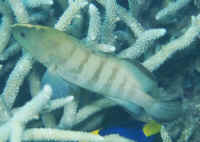
|
Bigger PIX:
The images in this table are linked
to large (desktop size) copies. Click on "framed" images
to go to the larger size. |
|
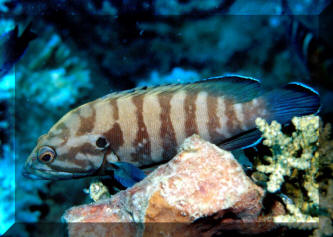
|
| Cephalopholis cruentata Lacepede 1802, the
Graysby. Tropical west Atlantic. To fourteen inches maximum length.
A regular offering in the aquarium trade, though not a great
beauty. Capable of rapid color, marking changes. This one in the
Bahamas. For comparison, though it is very rarely offered in the
trade, the Panamic Graysby, Cephalopholis panamensis
(Steindachner 1877), is shown. |
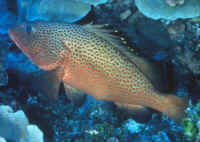
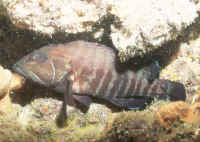
|
Bigger PIX:
The images in this table are
linked to large (desktop size) copies. Click on "framed"
images to go to the larger size. |
%20MD.jpg)
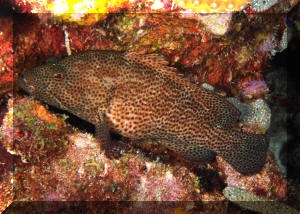
%20MD.jpg)
%20MD.JPG)
%20MD.JPG)
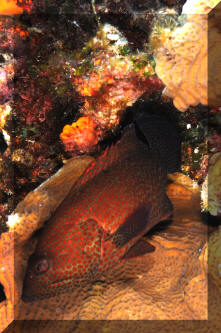 |
| Cephalopholis cyanostigma (Valenciennes
1828), Bluespotted Rockcod. Western Pacific; Philippines to
Australia. To fourteen inches overall length. One skulking around
Redang, Malaysia, the vertical off Queensland,
Australia. |
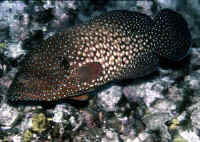 
|
Bigger PIX:
The images in this table are linked
to large (desktop size) copies. Click on "framed" images
to go to the larger size. |
|
%20MD.JPG)
|
To:
part II,
part III

